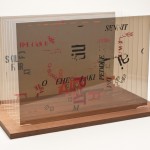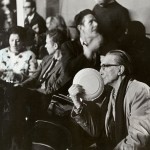Not Wanting to Say Anything About Marcel: An Artwork by John Cage
∞
 Once called a “polyartist” by his preeminent biographer, Richard Kostelanetz, John Cage (American, 1912-1992) has made an impact on many artistic disciplines—theater, dance, poetry, visual art and musical composition. His first forays into art involved music, and he is arguably best known for 4’33”, first performed in 1952. Cage composed a musical performance in which well-known pianist David Tudor sat at the piano in silence for four minutes and thirty-three seconds. By including noise as well as silence, 4’33” exemplifies Cage’s characteristic sense of humor and rebellion by both questioning and reaffirming traditional musical composition. By removing the music from a musical performance, he allowed the ambient noises from the uncomfortable audience to become just as much of the composition as the pianist and piano onstage.
Once called a “polyartist” by his preeminent biographer, Richard Kostelanetz, John Cage (American, 1912-1992) has made an impact on many artistic disciplines—theater, dance, poetry, visual art and musical composition. His first forays into art involved music, and he is arguably best known for 4’33”, first performed in 1952. Cage composed a musical performance in which well-known pianist David Tudor sat at the piano in silence for four minutes and thirty-three seconds. By including noise as well as silence, 4’33” exemplifies Cage’s characteristic sense of humor and rebellion by both questioning and reaffirming traditional musical composition. By removing the music from a musical performance, he allowed the ambient noises from the uncomfortable audience to become just as much of the composition as the pianist and piano onstage.
Relinquishing certain aspects of the outcome within an established framework was Cage’s way of eliminating biases or personal taste from his work. It is within this realm of “chance operations” that Cage composed and created—parameters are established but chance is then allowed to play out in the form of sound, text or visual art.
 In 1969, while he was the composer-in-residence at the University of Cincinnati, Cage was prompted by art patron Alice Weston to create his first visual artwork, Not Wanting to Say Anything About Marcel. The year before, the art world lost one of the founding fathers of conceptual art, Marcel Duchamp, who was both a friend to and an influence on Cage. At that same time, an uncited art publication solicited several artists, Cage among them, to do something to honor Duchamp. He and Jasper Johns, a fellow artist and friend, were discussing the publication’s request, and it was Johns who said, “I don’t want to say anything about Marcel.” Cage took this statement and used it for the title of his first venture into the visual art world. The Museum is pleased to spotlight this seminal work, Not Wanting to Say Anything About Marcel (1969), from September 24, 2010, to March 28, 2011.
In 1969, while he was the composer-in-residence at the University of Cincinnati, Cage was prompted by art patron Alice Weston to create his first visual artwork, Not Wanting to Say Anything About Marcel. The year before, the art world lost one of the founding fathers of conceptual art, Marcel Duchamp, who was both a friend to and an influence on Cage. At that same time, an uncited art publication solicited several artists, Cage among them, to do something to honor Duchamp. He and Jasper Johns, a fellow artist and friend, were discussing the publication’s request, and it was Johns who said, “I don’t want to say anything about Marcel.” Cage took this statement and used it for the title of his first venture into the visual art world. The Museum is pleased to spotlight this seminal work, Not Wanting to Say Anything About Marcel (1969), from September 24, 2010, to March 28, 2011.
 Four Plexigrams, each made of eight sheets of Plexiglas silkscreened with letters, numbers and images, are held by a wooden base. Included with this serialized edition is one of two lithographs. Lithograph A, included with the Museum’s set of Plexigrams, consists of text and imagery printed on black Fabriano rag utilizing the same chance operations as the Plexigrams for composition.
Four Plexigrams, each made of eight sheets of Plexiglas silkscreened with letters, numbers and images, are held by a wooden base. Included with this serialized edition is one of two lithographs. Lithograph A, included with the Museum’s set of Plexigrams, consists of text and imagery printed on black Fabriano rag utilizing the same chance operations as the Plexigrams for composition.
In this work, the flip of a coin determined the process for visual production. Cage used I Ching, the Chinese “Book of Changes,” a numerical system with 64 possible outcomes, to determine the design of both the Plexiglas and the lithographs. Cage composed the artwork with the assistance of graphic designer Calvin Sumison and lithographic printers Irwin Hollander and Fred Genis.

 Visually present in the lithographs on black paper, but most evident in the Plexigrams, is Cage’s use of negative space. The erasure, juxtaposition and overlapping of text and images on the layers of Plexiglas enables them to be read in multiple combinations. In effect, Cage is exploring the meaning of these words and images by making the viewer finish them. By allowing the viewer to complete the artwork’s reception, Cage opens interpretation far beyond the reach of his chance operations. Essentially, the viewer is limited only by his or her own imagination.
Visually present in the lithographs on black paper, but most evident in the Plexigrams, is Cage’s use of negative space. The erasure, juxtaposition and overlapping of text and images on the layers of Plexiglas enables them to be read in multiple combinations. In effect, Cage is exploring the meaning of these words and images by making the viewer finish them. By allowing the viewer to complete the artwork’s reception, Cage opens interpretation far beyond the reach of his chance operations. Essentially, the viewer is limited only by his or her own imagination.
 By utilizing chance and eliminating his own personal choices, Cage removes the artist’s hands from the artwork. While not wanting to say anything, Cage says everything and pays the ultimate homage to Marcel.
By utilizing chance and eliminating his own personal choices, Cage removes the artist’s hands from the artwork. While not wanting to say anything, Cage says everything and pays the ultimate homage to Marcel.


Leave your comment
You must be logged in to post a comment.